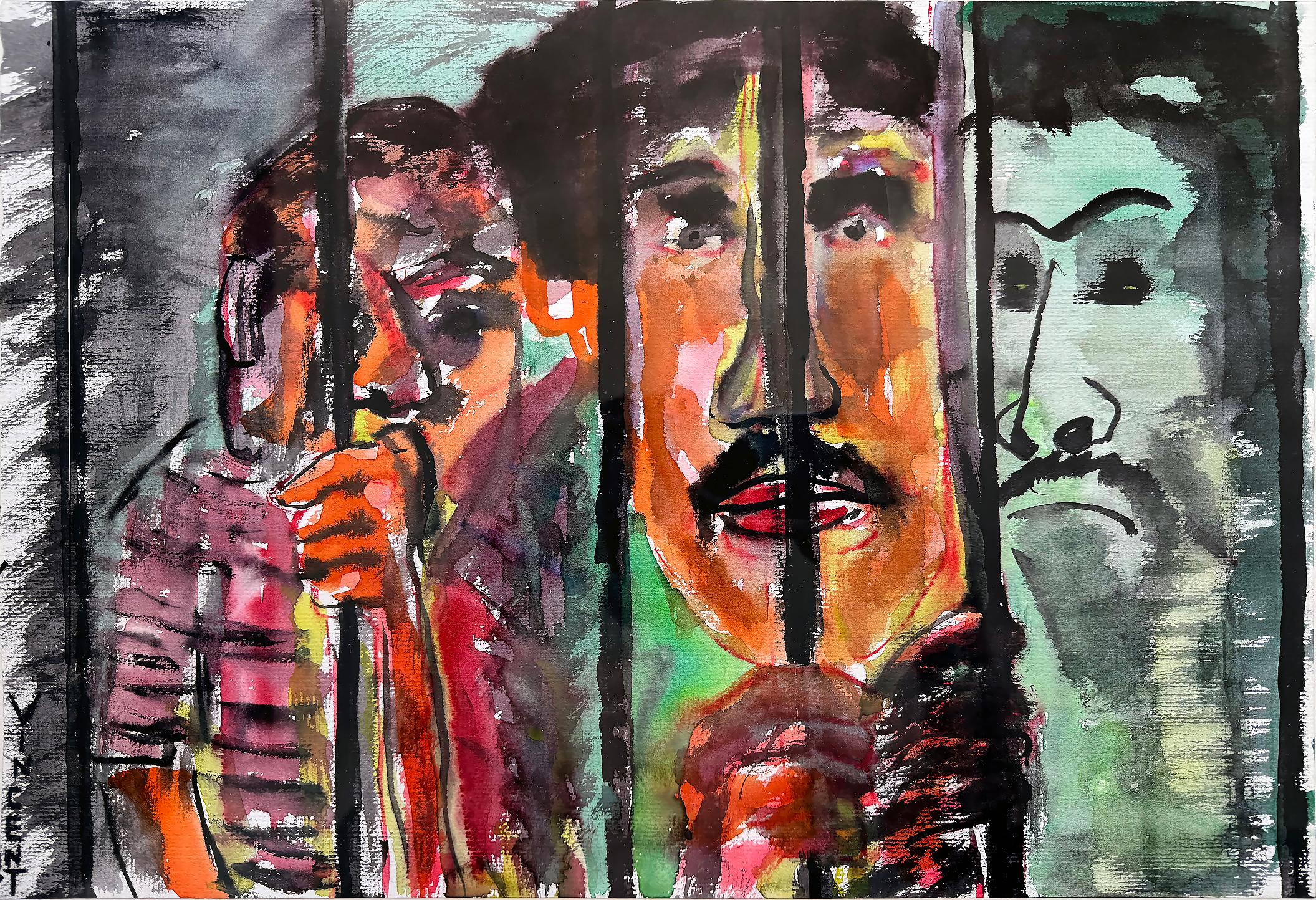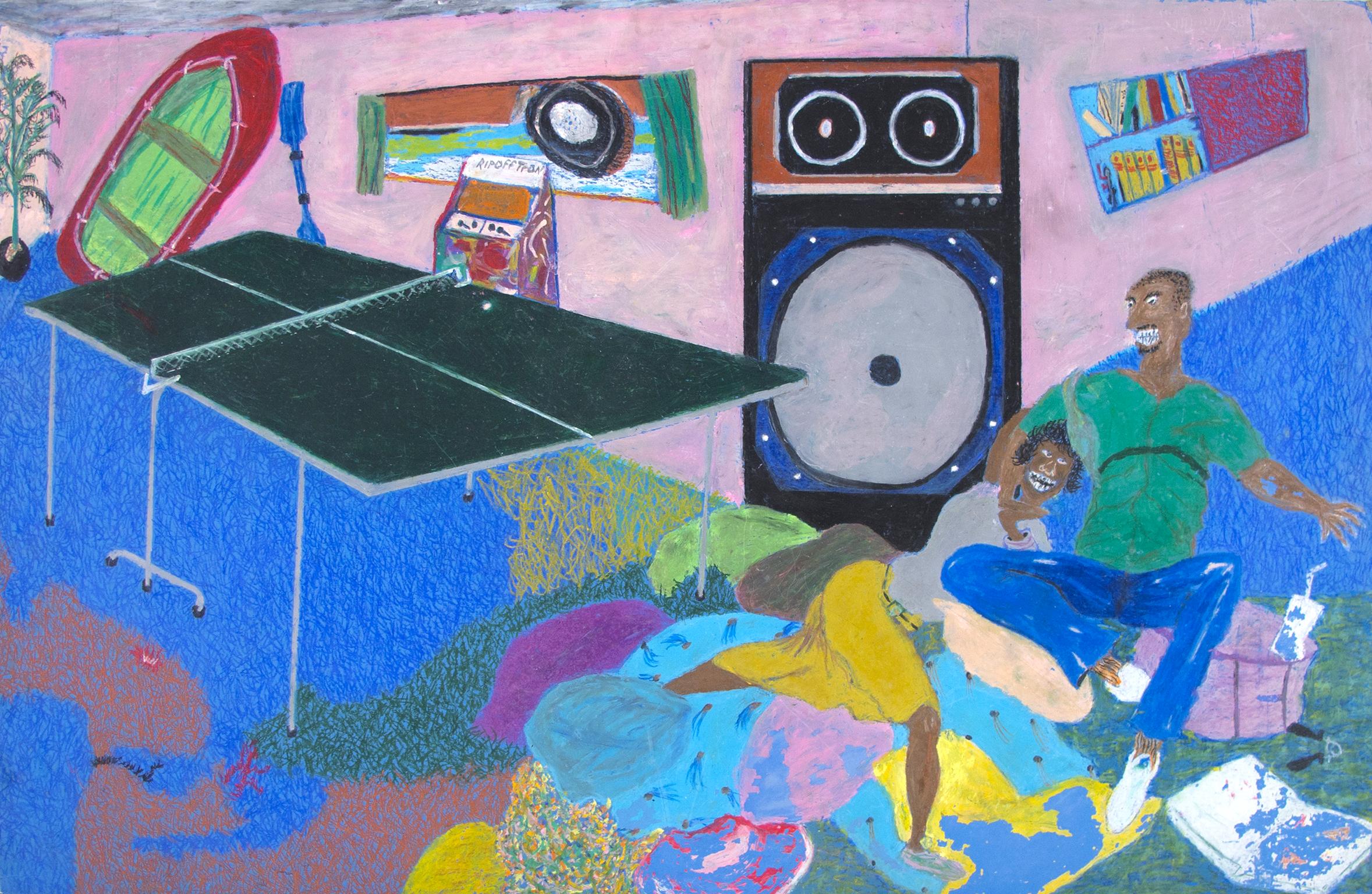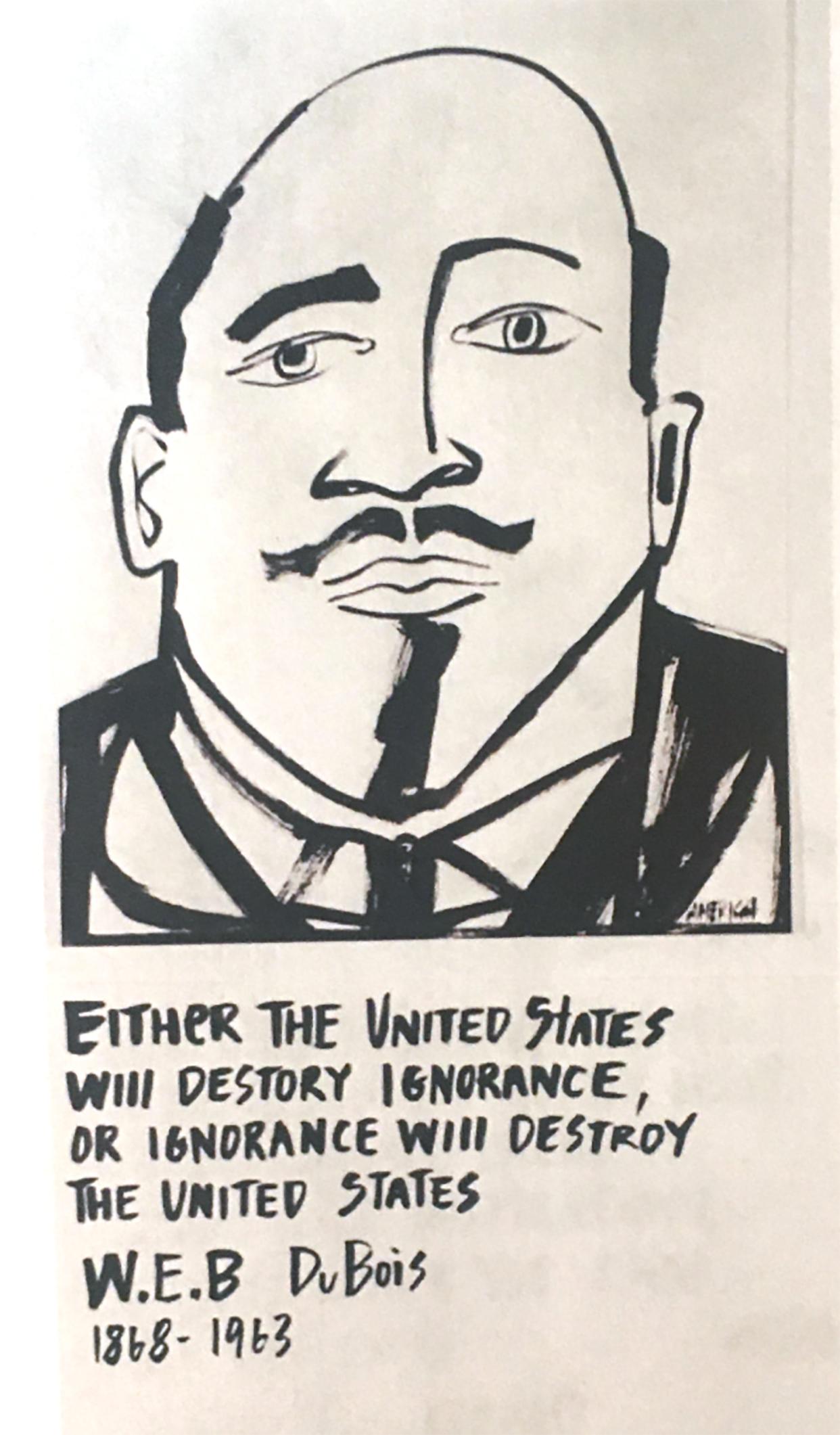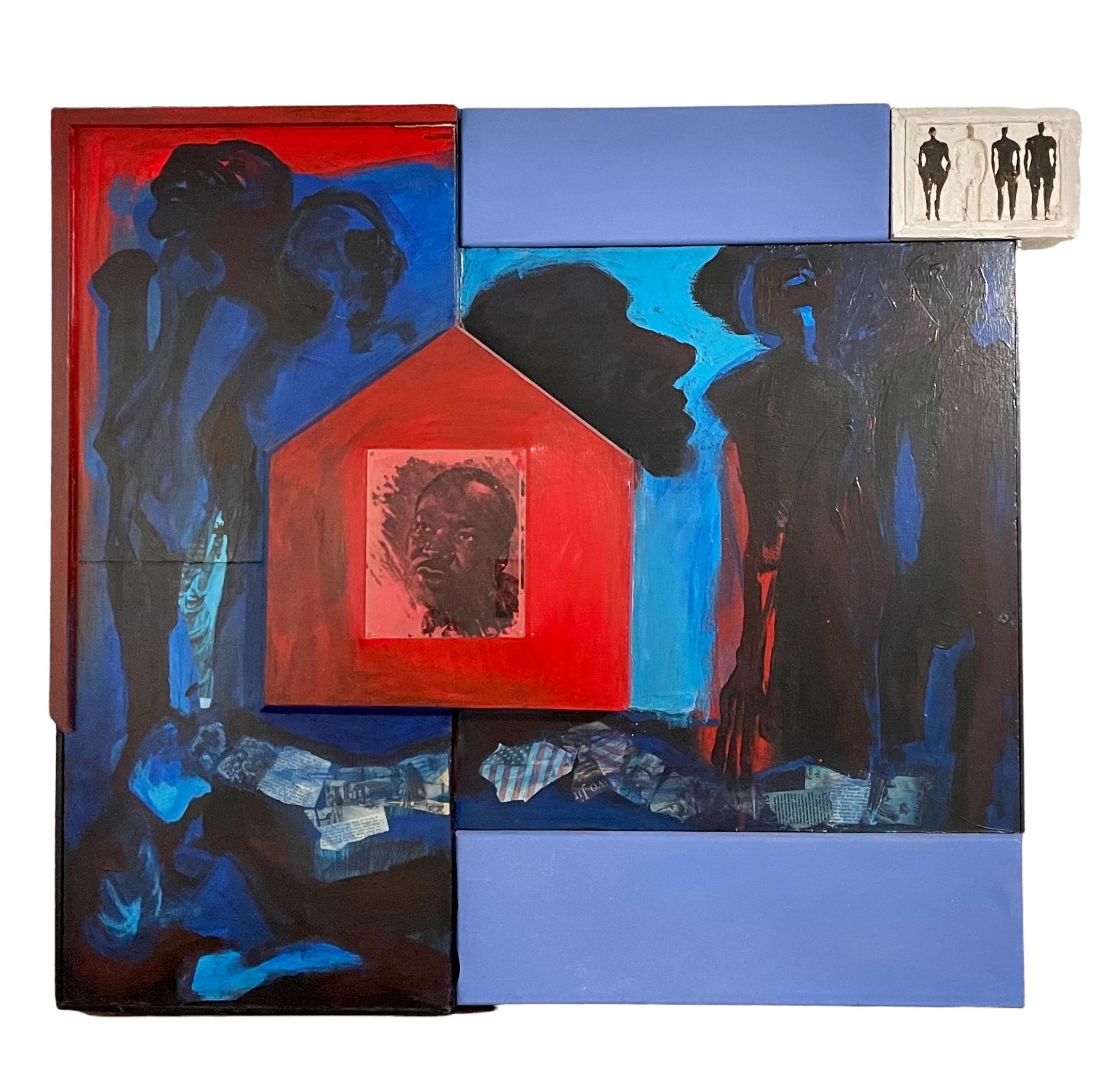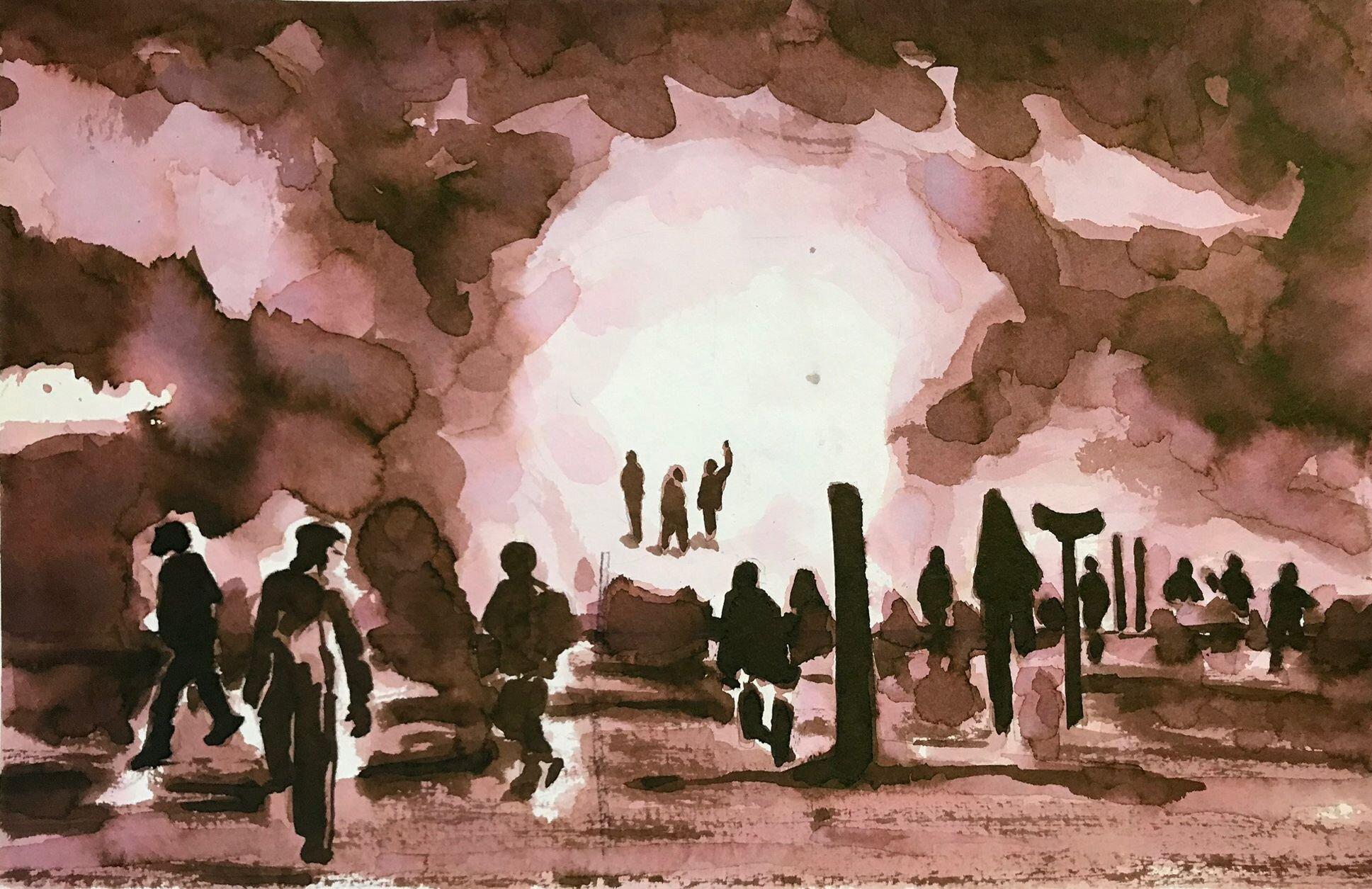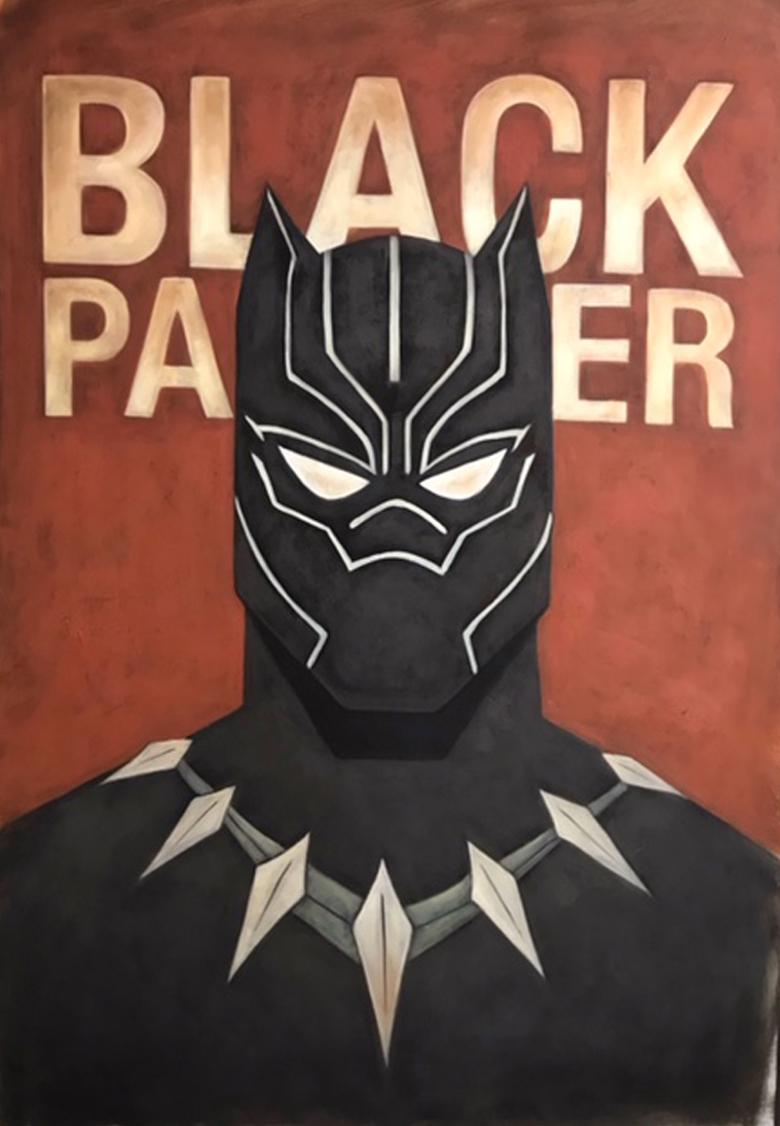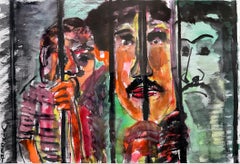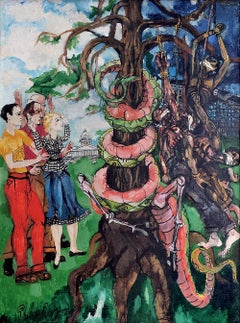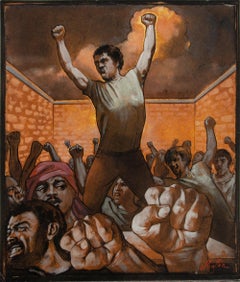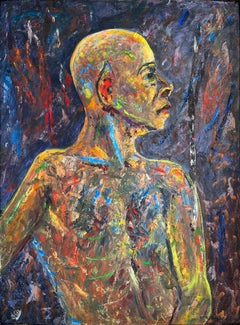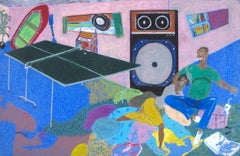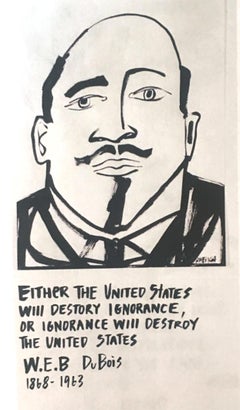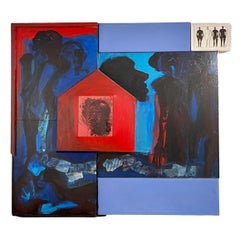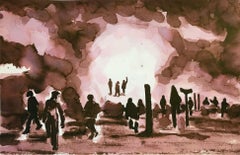Items Similar to Black Panther Trials - Civil Rights Movement Police Violence African American
Video Loading
Want more images or videos?
Request additional images or videos from the seller
1 of 15
Vincent D SmithBlack Panther Trials - Civil Rights Movement Police Violence African American1970
1970
$12,000
£9,110.20
€10,420.12
CA$16,765.74
A$18,647.16
CHF 9,736.97
MX$226,916.14
NOK 124,355.95
SEK 116,623.94
DKK 77,769.35
Shipping
Retrieving quote...The 1stDibs Promise:
Authenticity Guarantee,
Money-Back Guarantee,
24-Hour Cancellation
About the Item
The Black Panther Trials - In this historically significant work, African American Artist Vicent D. Smith functions as an Art Journalist/ Court Reporter as much as a
Artist. Here, he depicts, in complete unity, 21 Black Panther Protestors raising their fist of defiance at the White Judge. Smith's composition is about utter simplicity, where the Black Panther Protestors are symmetrically lined up in a confrontation with a Judge whose size is exaggerated in scale. Set against a stylized American Flag, the supercilious Judge gazes down as the protesters as their fists thrust up. Signed Vincent lower right. Titled Panter 21. Original metal frame. Tape on upper left edge of frame. 255 . Panther 21. Framed under plexi.
_____________________________
From Wikipedia
In 1969-1971 there was a series of criminal prosecutions in New Haven, Connecticut, against various members and associates of the Black Panther Party.[1] The charges ranged from criminal conspiracy to first-degree murder. All charges stemmed from the murder of 19-year-old Alex Rackley in the early hours of May 21, 1969. The trials became a rallying-point for the American Left, and marked a decline in public support, even among the black community, for the Black Panther Party
On May 17, 1969, members of the Black Panther Party kidnapped fellow Panther Alex Rackley, who had fallen under suspicion of informing for the FBI. He was held captive at the New Haven Panther headquarters on Orchard Street, where he was tortured and interrogated until he confessed. His interrogation was tape recorded by the Panthers.[2] During that time, national party chairman Bobby Seale visited New Haven and spoke on the campus of Yale University for the Yale Black Ensemble Theater Company.[3] The prosecution alleged, but Seale denied, that after his speech, Seale briefly stopped by the headquarters where Rackley was being held captive and ordered that Rackley be executed. Early in the morning of May 21, three Panthers – Warren Kimbro, Lonnie McLucas, and George Sams, one of the Panthers who had come East from California to investigate the police infiltration of the New York Panther chapter, drove Rackley to the nearby town of Middlefield, Connecticut. Kimbro shot Rackley once in the head and McLucas shot him once in the chest. They dumped his corpse in a swamp, where it was discovered the next day. New Haven police immediately arrested eight New Haven area Black Panthers. Sams and two other Panthers from California were captured later.
Sams and Kimbro confessed to the murder, and agreed to testify against McLucas in exchange for a reduction in sentence. Sams also implicated Seale in the killing, telling his interrogators that while visiting the Panther headquarters on the night of his speech, Seale had directly ordered him to murder Rackley. In all, nine defendants were indicted on charges related to the case. In the heated political rhetoric of the day, these defendants were referred to as the "New Haven Nine", a deliberate allusion to other cause-celebre defendants like the "Chicago Seven".
The first trial was that of Lonnie McLucas, the only person who physically took part in the killing who refused to plead guilty. In fact, McLucas had confessed to shooting Rackley, but nonetheless chose to go to trial.
Jury selection began in May 1970. The case and trial were already a national cause célèbre among critics of the Nixon administration, and especially among those hostile to the actions of the FBI. Under the Bureau's then-secret "Counter-Intelligence Program" (COINTELPRO), FBI director J. Edgar Hoover had ordered his agents to disrupt, discredit, or otherwise neutralize radical groups like the Panthers. Hostility between groups organizing political dissent and the Bureau was, by the time of the trials, at a fever pitch. Hostility from the left was also directed at the two Panthers cooperating with the prosecutors. Sams in particular was accused of being an informant, and lying to implicate Seale for personal benefit.
In the days leading up to a rally on May Day 1970, thousands of supporters of the Panthers arrived in New Haven individually and in organized groups. They were housed and fed by community organizations and by sympathetic Yale students in their dormitory rooms. The Yale college dining halls provided basic meals for everyone. Protesters met daily en masse on the New Haven Green across the street from the Courthouse (and one hundred yards from Yale's main gate). On May Day there was a rally on the Green, featuring speakers including Jean Genet, Abbie Hoffman, Jerry Rubin, and John Froines (an assistant professor of chemistry at the University of Oregon). Teach-ins and other events were also held in the colleges themselves.
Towards midnight on May 1, two bombs exploded in Yale's Ingalls Rink, where a concert was being held in conjunction with the protests.[4] Although the rink was damaged, no one was injured, and no culprit was identified.[4]
Yale chaplain William Sloane Coffin stated, "All of us conspired to bring on this tragedy by law enforcement agencies by their illegal acts against the Panthers, and the rest of us by our immoral silence in front of these acts," while Yale President Kingman Brewster Jr. issued the statement, "I personally want to say that I'm appalled and ashamed that things should have come to such a pass that I am skeptical of the ability of a Black revolutionary to receive a fair trial anywhere in the U.S." Brewster's generally sympathetic tone enraged many of the university's older, more conservative alumni, heightening tensions within the school community.
As tensions mounted, Yale officials sought to avoid deeper unrest and to deflect the real possibility of riots or violent student demonstrations. Sam Chauncey has been credited with winning tactical management on behalf of the administration to quell anxiety among law enforcement and New Haven's citizens, while Kurt Schmoke, a future Rhodes Scholar, mayor of Baltimore, MD and Dean of Howard University School of Law, has received kudos as undergraduate spokesman to the faculty during some of the protest's tensest moments. Ralph Dawson, a classmate of Schmoke's, figured prominently as moderator of the Black Student Alliance at Yale (BSAY).
In the end, compromises between the administration and the students - and, primarily, urgent calls for nonviolence from Bobby Seale and the Black Panthers themselves - quashed the possibility of violence. While Yale (and many other colleges) went "on strike" from May Day until the end of the term, like most schools it was not actually "shut down". Classes were made "voluntarily optional" for the time and students were graded "Pass/Fail" for the work done up to then.
Trial of McLucas
Black Panther trial sketch by Robert Templeton
McLucas's trial set new records for the scale of judicial proceedings in Connecticut. It was the first in Connecticut to have metal detectors installed at the courtroom doors; jury selection took six weeks, a Connecticut record, and the jury deliberated for six days, another Connecticut record.[5] Despite impassioned accusations from protesters that McLucas was being railroaded into the electric chair by a "racist jury,"[6] the jurors (ten white, two black) acquitted him on the most severe charges, convicting him instead on the sole charge of conspiracy to commit murder. His defense attorney declared, "The judge was fair, the jury was fair, and, in this case, a black revolutionary was given a fair trial."[7] McLucas was sentenced to twelve to fifteen years in prison. His two collaborators in the murder, who had pleaded to second degree murder, were released after four years.[5][8][9]
Trial of Seale and Huggins
Courtroom portraits including Huggins, Kimbro, Seale and Sams, 1970.
In October, 1970, Bobby Seale went on trial alongside Ericka Huggins, founder of the New Haven chapter. This trial was an even larger undertaking, involving a full four months of jury selection. Seale's attorney Charles Garry emphasized that it was only Sams's testimony that tied Seale to Rackley's murder. Huggins's voice was heard on a tape recording of the victim's interrogation, played for the jury. Her lawyer, Catherine Roraback, argued that Huggins had been acting under duress.[2] The jury was unable to reach a verdict, deadlocked 11 to 1 for Seale's acquittal and 10 to 2 for Huggins' acquittal. On May 25, 1971 Judge Harold Mulvey stunned courtroom spectators by dismissing the charges against Huggins and Seale, saying, "I find it impossible to believe that an unbiased jury could be selected without superhuman efforts—efforts which this court, the state and these defendants should not be called upon either to make or to endure."[10]
"Ericka Huggins and Bobby Seale would have to stand trial for their lives because they had been unyielding in their efforts to forge liberating actions for Black people. And there were innumerable other instances of frame-ups and similar political reprisals."
— Angela Davis, Ebony, July 1971, page 117
Popular sentiments
Both the Panthers and the FBI suffered damage to their reputations, after the public exposure of their most unsavory activities.
In 1971, a group of left-wing radicals calling themselves the Citizens' Commission to Investigate the FBI burglarized an FBI field office in Media, Pennsylvania, which was found to be spying on Swarthmore College students and faculty. Among the materials stolen in this break-in were documents revealing the nature of the COINTELPRO program. Within the year, Director Hoover declared that the centralized COINTELPRO was over.[11]
For the Panthers, the Seale trial may have been the height of their national exposure and their popularity among the broader left-wing movement. A string of violent confrontations with law-enforcement, along with the trials and convictions of national party leaders that followed, left the movement spent and adrift, and by the mid-1970s it was largely inactive.
Revelations
The Seale trial surfaced again in the news in 2000, when former first lady Hillary Clinton ran for U.S. Senate in the state of New York. Anti-Clinton activists discovered that during the trials, Clinton (then a Yale law student named Hillary Rodham) volunteered to monitor the trial for violations of civil rights, for the American Civil Liberties Union. Widely circulated mass e-mails erroneously ascribed to Clinton responsibility for "getting the defendants off," and also blamed the future head of the Clinton U.S. Justice Department's Civil Rights Division, Bill Lann Lee, who was a Yale undergraduate at the time.[12] Although both were much too junior to have had any role in the actual legal defense, according to John Elvin of the conservative newsmagazine Insight on the News, "Insight reviewed biographies of Hillary Clinton by Milton, [David] Brock and Roger Morris for this story and lengthy selections from such other biographies as Barbara Olson's Hell to Pay. Together, relying on primary and other firsthand sources, they unquestionably back David Horowitz's contention that Hillary was a campus leader during the Panther protests";[13] Lee apparently played no prominent role in any protests.[14]
In 2006, Kelly Moye revealed that he was a police informant recruited to infiltrate the Panthers by Nick Pastore, head of New Haven Police's Intelligence Division. George Sams held a gun to Moye's head and demanded he turn over his car. Rackley was driven to his death in Moye's car. The police followed Moye's car as it left toward the murder destination but lost sight of the car prior to the murder.[15] The State Police discovered Rackley's body the next day. This epilogue was detailed in an article "After 37 Years, Spy Comes In From Cold" by Paul Bass, author of Murder In The Model City: The Black Panthers, Yale and the Redemption of a Killer.
Detective Nick Pastore, who arrested Seale and brought him to New Haven to stand trial, went on to become New Haven's Chief of Police, widely renowned for his successful policy of community policing, and then headed a nonprofit advocacy group in Washington, DC named Criminal Justice Policy. Thirty-one years later, when Seale returned to New Haven to speak at the Yale Repertory Theatre, Pastore decided to attend and even presented Seale with a pink porcelain pig and a hug, congratulating him for continuing "the struggle".[9]
- Creator:Vincent D Smith (1929 - 2003, American)
- Creation Year:1970
- Dimensions:Height: 12 in (30.48 cm)Width: 16 in (40.64 cm)
- Medium:
- Movement & Style:
- Period:
- Condition:some discoloration to the paper on left new edge.
- Gallery Location:Miami, FL
- Reference Number:1stDibs: LU385314628312
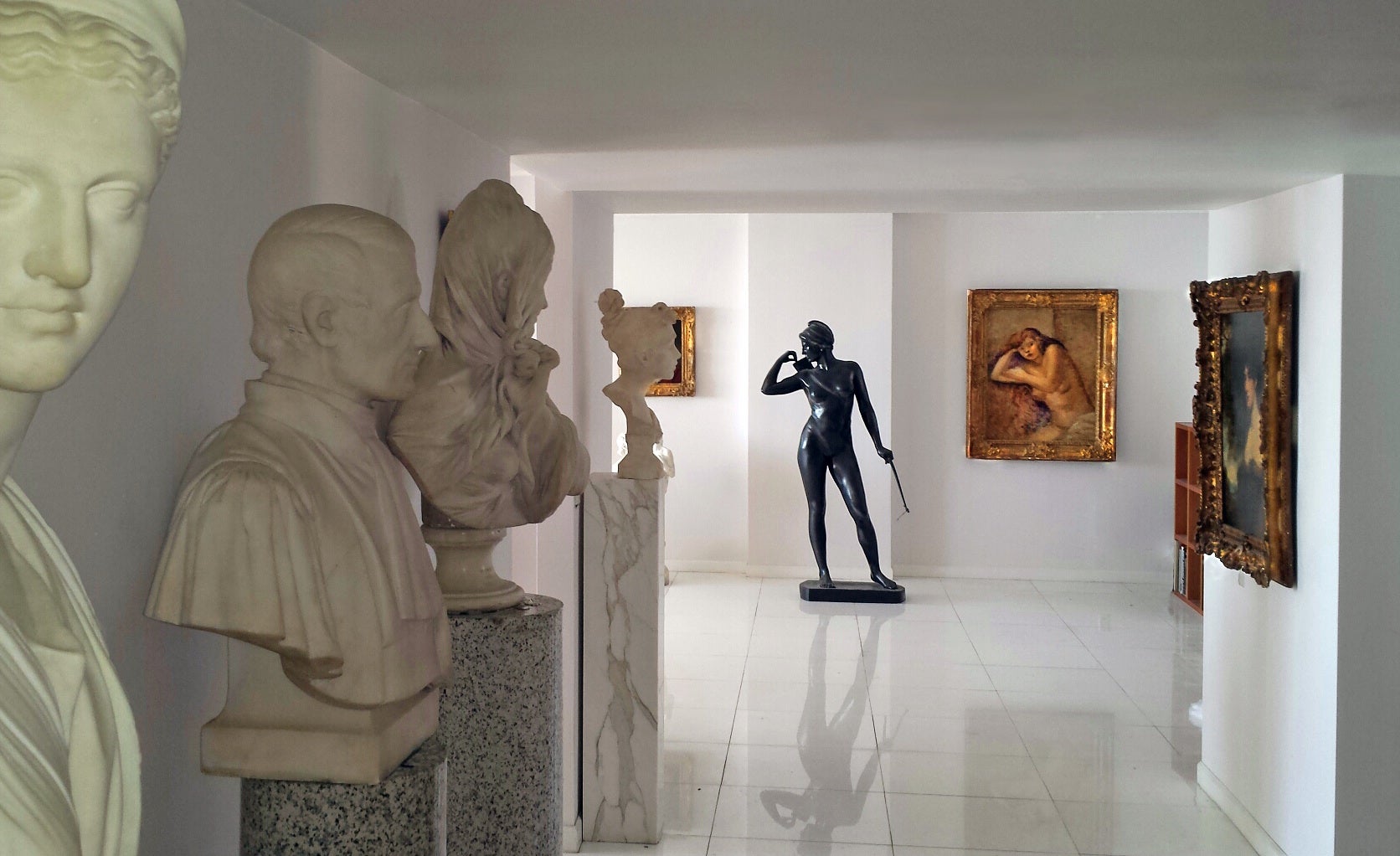
About the Seller
4.9
Gold Seller
Premium sellers maintaining a 4.3+ rating and 24-hour response times
Established in 2005
1stDibs seller since 2016
115 sales on 1stDibs
Typical response time: 1 hour
- ShippingRetrieving quote...Shipping from: Miami, FL
- Return Policy
Authenticity Guarantee
In the unlikely event there’s an issue with an item’s authenticity, contact us within 1 year for a full refund. DetailsMoney-Back Guarantee
If your item is not as described, is damaged in transit, or does not arrive, contact us within 7 days for a full refund. Details24-Hour Cancellation
You have a 24-hour grace period in which to reconsider your purchase, with no questions asked.Vetted Professional Sellers
Our world-class sellers must adhere to strict standards for service and quality, maintaining the integrity of our listings.Price-Match Guarantee
If you find that a seller listed the same item for a lower price elsewhere, we’ll match it.Trusted Global Delivery
Our best-in-class carrier network provides specialized shipping options worldwide, including custom delivery.More From This Seller
View AllBlack Power, Attica Prison Riot Prisoners Racial Justice - African American Art
Located in Miami, FL
African American Artist Vincent D Smith makes a statement about racial justice. In this work from 1972, he depicts three African American prisoners with their faces pushed up agains...
Category
1970s Modern Figurative Drawings and Watercolors
Materials
Watercolor
Civil Rights, Racial Justice Little Rock
By Philip Evergood
Located in Miami, FL
"Civil Rights." Evergood's early commentary on racial issues in the 1950s depicts four black men gagged, roped and hanging from a tree. In the background, imprisoned blacks look on through a barbed-wire fence. Whites watch in horror but do nothing to help. Meanwhile, a two-legged and three-headed serpent who symbolizes evil - wraps himself around the tree that physically and symbolically separates the races. This is an important work in the history of American art. It may be one of the very earliest examples of a major American painter doing a major work that challenges racial segregation and injustice at a time when no one else would. The title of the work is inspired by a Historic Supreme Court decision on racial segregation. The Little Rock...
Category
1950s American Realist Figurative Paintings
Materials
Oil
Protest Revolt and Uprising illustration
By Daniel Maffia
Located in Miami, FL
This work is a quintessential protest statement piece depicting an angry mob brandishing powerful fits in the air in gestures of revolt
Signed lower right.
Daniel Maffia has done a ...
Category
1980s American Modern Figurative Paintings
Materials
Mixed Media, Gouache
Devil: No Horns, Burning in Hell, African American Harlem Renaissance
Located in Miami, FL
In a 1971 interview with Ebony Magazine, Alvin Hollinsworth commented on his African Jesus Christ painting, "I have always felt that Christ was a Blac...
Category
1970s Expressionist Figurative Paintings
Materials
Masonite, Oil
Black Power Fist, Thumbs Up, Peace Sign - Hand Signals
By Murray Tinkelman
Located in Miami, FL
Murray Tinkelman builds his works out of tiny meticulously placed cross hatchings that are organized into horizontal and diagonal structures. Most are done with a ruler and some fre...
Category
1970s Pointillist Figurative Drawings and Watercolors
Materials
Ink, Pen
Portrait of African Man by African American Artist Expressionist Brush Strokes
Located in Miami, FL
This Portrait of an African Man by an African American artist exhibits penetrating psychological insight and is executed in vibrant colors with quick gestural post-expressionist brus...
Category
1960s Expressionist Portrait Drawings and Watercolors
Materials
Paper, Watercolor, Pen
You May Also Like
"Dedicated to Harold Washington, Mayor of Chicago, IL, USA, " by Reginald K. Gee
By Reginald K. Gee
Located in Milwaukee, WI
"Dedicated to Harold Washington, Mayor of Chicago, IL, USA" is an original oil pastel drawing on illustration board by Reginald K. Gee. The artist signed the piece on the back. It de...
Category
1990s Contemporary Interior Drawings and Watercolors
Materials
Oil Pastel, Illustration Board
W.E.B duBois, America Martin_Ink on Paper_portion of sale to ACLU/NAACP
By America Martin
Located in Laguna Beach, CA
A portion of each sale will be donated to the ACLU + NAACP
JoAnne Artman Gallery proudly introduces America Martin’s new series I See Heroes Everywhere.
Addressing the theme of her...
Category
2010s Contemporary Figurative Paintings
Materials
Ink, Archival Paper
$3,600 Sale Price
20% Off
Large Painting Photo Collage Martin Luther King African American Civil Rights
Located in Surfside, FL
This depicts civil rights icon MLK, the Statue of Liberty, Iwo Jima, an assemblage of mixed media photographic images and painted collaged elements. A powerful, moving work, an ode t...
Category
1990s Contemporary Mixed Media
Materials
Glass, Mixed Media, Acrylic, Photographic Paper
Protest, Painting, Watercolor on Paper
By Toby Corbett
Located in Yardley, PA
The Dakota Access Pipeline protests, also known by the hashtag #NoDAPL, are grassroots movements that began in early 2016 in reaction to the approved construction of Energy Transfer ...
Category
2010s Contemporary Drawings and Watercolor Paintings
Materials
Watercolor
Black Panther l
By Y.m.Lo
Located in East Hampton, NY
Black Panther
Oil Painting
There are more super hero painting
Comes ROLLED in a tube
Needs framing
NY Artist Y.M. Lo oil painting.
contemporary art in ...
Category
2010s Outsider Art Animal Paintings
Materials
Oil
$480 Sale Price
20% Off
"The People People 6" by Tracy Crump
Located in Chicago, IL
In this series entitled "The People People," Tracy Crump uses washes of white, red and aqua to both conceal and reveal sensitively drawn figures. Each fig...
Category
21st Century and Contemporary Outsider Art Figurative Drawings and Water...
Materials
Paper, Ink, Acrylic, Watercolor
More Ways To Browse
African American Art Signed
Vintage African American Paintings
David Smith Artist
Black Panther
Paintings By D Smith
Jean Smith
Africa Door
John Smith Vintage
Police Signs
Vintage Police Art
Old California Watercolors
D J David
American Artist William Smith
Large American Flag
Large Panther
Vintage Black And White Sketches
Vintage Car Drawing
J Smith Painting
